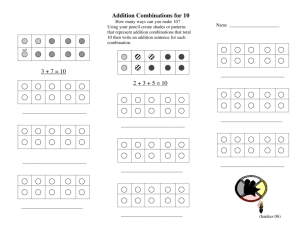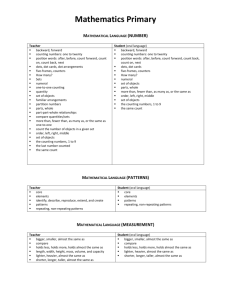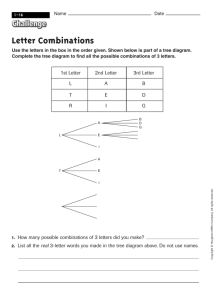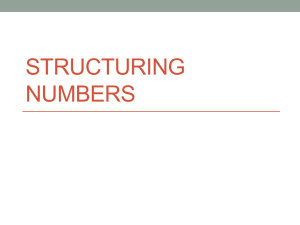AS - Stage 1
advertisement
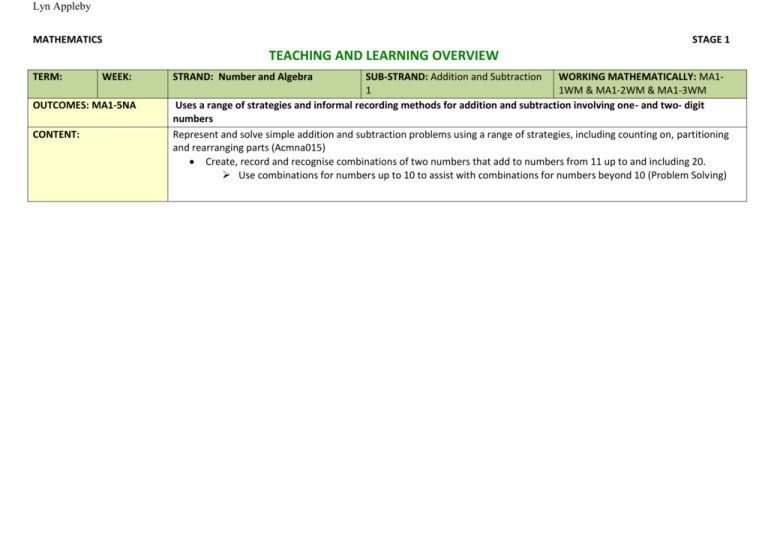
Lyn Appleby MATHEMATICS STAGE 1 TEACHING AND LEARNING OVERVIEW TERM: WEEK: OUTCOMES: MA1-5NA CONTENT: STRAND: Number and Algebra SUB-STRAND: Addition and Subtraction WORKING MATHEMATICALLY: MA11 1WM & MA1-2WM & MA1-3WM & involving one- and two- digit Uses a range of strategies and informal recording methods for addition and subtraction numbers Represent and solve simple addition and subtraction problems using a range of strategies, including counting on, partitioning and rearranging parts (Acmna015) Create, record and recognise combinations of two numbers that add to numbers from 11 up to and including 20. Use combinations for numbers up to 10 to assist with combinations for numbers beyond 10 (Problem Solving) Lyn Appleby ASSESSMENT FOR LEARNING (PRE-ASSESSMENT) Students must be able to : • count orally to ten in the correct order • name the number word before or after a given number • match each number word to one, and only one, object when counting. Class discussion and questioning about combinations of numbers to 10 e.g. “Who knows which two numbers go together to make ten?” This should give an idea about whether the students will understand the content to be taught. WARM UP / DRILL TENS ACTIVITY (DENS) QUALITY TEACHING ELEMENTS RESOURCES Three-minute lesson breakers •Perceptual - “Hold your hands up and quickly form finger patterns representing numbers. You may flash a finger pattern for a single-digit number or make a two-digit number by flashing ten fingers as many times as necessary, followed by a pattern representing a single digit.” The students silently add the numbers and call out the answer. Figurative - Oral counting using the hundred chart. • Think of a “secret number” and provide the students with clues for guessing the “secret number”. Include simple and complex clues. For example: “The secret number is two more than three.” “The secret number is more than twelve but less than nineteen.” “The secret number is an odd number between 10 and 20.” Counting On - Organise the students into a circle with all of the students facing into the centre. Lead the group in oral counting chants, for example, counting by 2s, 5s, 10s or odds and evens. Ask a student to nominate a body action which the group can perform with each count. INTELLECTUAL QUALITY QUALITY LEARNING ENVIRONMENT SIGNIFICANCE Deep knowledge Deep understanding Problematic knowledge Higher-order thinking Metalanguage Substantive communication Explicit quality criteria Engagement High expectations Social support Students’ self-regulation Student direction Background knowledge Cultural knowledge Knowledge integration Inclusivity Connectedness Narrative Developing efficient numeracy strategies Stage 1 department of Education and Training 2002 Count Me In Too Games Snappymaths Primary resources.co.uk Sparklebox Lyn Appleby TEACHING AND LEARNING EXPERIENCES WHOLE CLASS INSTRUCTION MODELLED ACTIVITIES Play Butterfly Ten Frame on the Count Me In Too website Whole class discussion about combinations of two numbers that add to 10. Model the use of ten frames on the smartboard by filling the frame with two different-coloured dots. Encourage students to discuss the number combinations they see on the ten frame. Demonstrate activity procedure. Display flash cards on Smartboard and discuss the numbers and dot patterns. Demonstrate activity procedure. Play butterfly wings on the Count Me In Too website. GUIDED & INDEPENDENT ACTIVITIES LEARNING SEQUENCE Remediation ES1 Perceptual Ten frames Variations • Provide individual ten frames for students and allow them to make their own patterns. Have students discuss in pairs the combinations they have made on their ten frame. Students could record their combinations by copying the patterns onto a stencil of blank ten frames or by writing the number combinations. Flash cards Give flash dot-pattern cards for numbers up to ten to the students. Provide students with a collection of counters so that they can construct the same pattern as on the dot-pattern card. Variations • Show a dot pattern to the students. Cover some dots and ask students to find a dot card to match the hidden dots. • Flash the dot pattern to the class and then cover some dots. Ask the students how many dots could be seen and how many are hidden if there are ten altogether. Complete sticker book “My Book of Numbers that make the number 10” Observations during activities for understanding. Mark sticker booklets Lyn Appleby LEARNING SEQUENCE S1 Figurative Friends of ten Construct two sets of numeral cards in the range of zero to ten. For this activity it is necessary to attach string or shoelaces to the numeral cards so they can be worn around the students’ necks. It is also more manageable if each set of cards is a different colour. Distribute one set of numeral cards to ten students. These students leave the room or turn away from the remaining students. Distribute the other set of numeral cards to the remaining students. Ask the students in the first group to return to the class (or turn around) and find a partner who is wearing a card which, when added to their own card, will equal ten. Variations • Increase the range of numbers on the numeral cards. • Change the cards so that one set displays numerals and the other set displays dot patterns. Dice toss Provide the students with two dice. Ask the students to take turns to roll the two dice and add them together to find the total. Provide material for students to record the number sentences. Complete Butterfly wing combinations to 10 worksheet. Making 10 Investigation worksheet Number bonds of 10 worksheets. Regular/weekly friends of 10 speed tests. Observations during activities for student understanding. Mark worksheets. Record weekly test scores. LEARNING SEQUENCE Extension Early S2 Counting On Bees Construct cardboard bees using the BLM on page 283 (DENS). Write numerals, selected from the range 11 to 20, on the middle section of each bee. On the wings, display dot patterns which, when added together, equal the numeral displayed on the body. The stencil will need to be cut so that the wings and body are in separate pieces. Place the wings and body parts down on the floor in a random arrangement. Ask the students to select one of the bee bodies and to find the correct pair of wings which, when the dot patterns are added together, will equal the numeral written on the body. Lyn Appleby Domino Addition Prepare domino cards which resemble commercially produced dominoes, or use traditional dominoes for this activity. Provide the students with a supply of the domino cards, or dominoes, and writing material. Deal five dominoes to each student in the group. Ask the students to record both dot patterns displayed on the dominoes as addition number sentences. Number bonds to 20 worksheets and weekly speed tests. EVALUATION & REFLECTION Sena 2 test component Combining and Partitioning. All assessment tasks should be written in red and planning should be based around developing the skills to complete that task. Assessment rubrics or marking scale should be considered.
